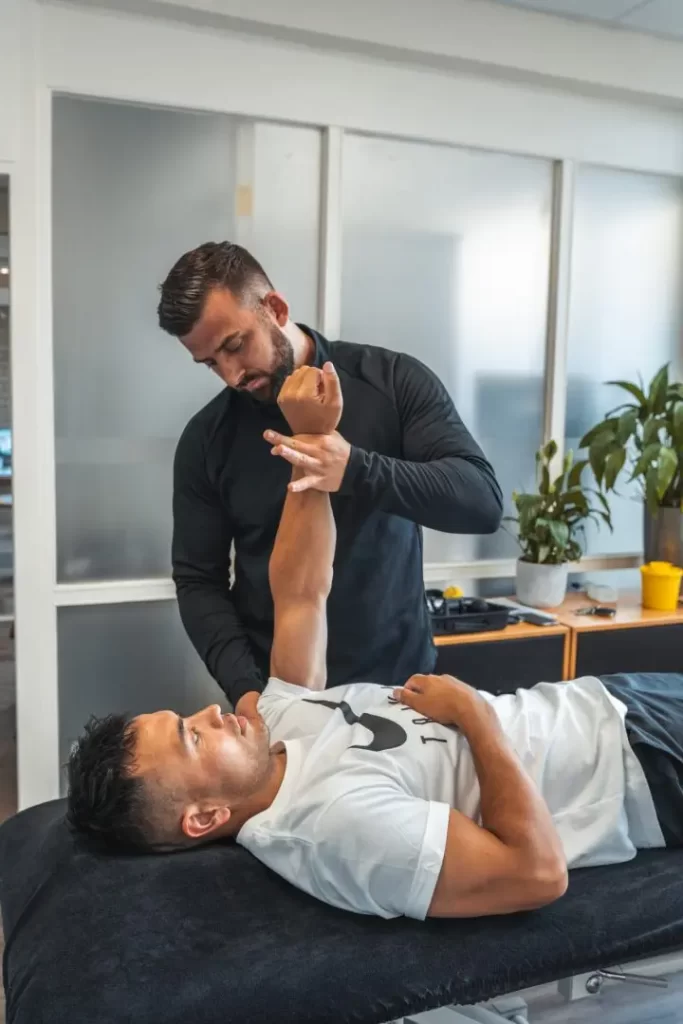Osteoporosis
From birth, our bodies are developing non-stop. First, we grow from baby to strong taxable people with a physical peak often around the age of 25. After that, we do notice that we slowly start to age. This process is visible outside (think of the skin), but is just as much going on inside. After on average our 45th year of life, the breakdown of bone will start to accelerate compared to the creation of the new. In women, we see that this process accelerates even more as oestrogen levels decrease after menopause. At the point when bone density decreases, osteoporosis (osteoporosis) may possibly occur. The presence of osteoporosis makes bones very porous and thus a lot more vulnerable in case of a fall, for instance.
Risk factors for developing osteoporosis
Several factors are known to contribute to the development of osteoporosis.
- Long-term use of corticosteroids (prednisolone)
- A low body weight (BMI <20)
- Smoking
- Menopause in women
- Little physical activity
In addition, osteoporosis can also occur in combination with other conditions such as:
- Diabetes
- Intestinal problems
- Rheumatoid arthritis (and related conditions)
- COPD
Symptoms in osteoporosis
Osteoporosis itself is painless. So you don't notice it at first. It only becomes a problem when you fall and possibly break something. After a bone fracture, osteoporosis is usually diagnosed by means of a dexa-scan. So the fracture is what causes the symptoms.
A spinal fracture mainly causes symptoms during movement. Getting up from a chair, for example, then causes back pain. With a slightly hunched posture, it is less painful. This is often also typical in people with osteoporosis. We call this posture kyphosis.
How is osteoporosis diagnosed?
Osteoporosis is diagnosed by a DEXA scan. This is a device that can determine the degree of bone density by means of X-rays. In the Netherlands, people over 50 are also called for a DEXA scan after a bone fracture. This helps to detect osteoporosis in time and advise people to start treatment plans. In addition, blood tests are often done to determine whether next vitamin D and calcium are present in the body.
The treatment of osteoporosis
As we get a bit older, our body's calcium needs increase. Calcium is needed for the good condition of our bones. Calcium is found in foods such as; dairy, soy and various vegetables/nuts/legumes. Do you find it difficult to get enough calcium with these products? Then you can discuss with your (family) physician whether it would be useful to take extra calcium tablets.
Calcium per se can do little without vitamin D. The body desperately needs vitamin D to absorb calcium into the blood and bind it to the bones. Ensuring sufficient vitamin D in the body is done by going outside sufficiently. In fact, sunlight is a natural stimulant for vitamin D production. You can also include certain products in your diet, such as fatty fish, butter, meat and eggs. Do you find it difficult to get enough calcium and/or vitamin D. Sometimes supplements can be a good addition. Consult your doctor or general practitioner about this.
Needless to say, we think it is good if you pay attention to calcium and vitamin D intake with osteoporosis. However nutrition with supplementary minerals and vitamins are not enough. In fact, research shows little to no results with just calcium and vitamin D intake. What does? A combination must be made with physical activity. Taking exercise stimulates our bone production, regardless of age or degree of osteoporosis. Several scientific studies already show that strength training in particular has a positive effect on bone tissue production. Besides being good for bones, this form of training also shows positive effects on joint quality, muscle strength and muscle mass.
Osteoporosis or osteopenia
The moment the quality of the bones deteriorates a little we do not immediately speak of osteoporosis. Between a 'normal' bone density and osteoporosis, we still place the designation osteopenia. This literally translated means 'a shortage of bone'. Of having osteopenia you feel nothing and in many cases you notice very little. Having osteopenia does not immediately result in an increased risk of bone fractures. However, it is important to take action when osteopenia is detected. In order to prevent osteoporosis, osteoporosis does increase the risk of fractures.
Gradations of osteoporosis
Osteoporosis is most commonly seen in the hips/pelvis and back. It is often discovered after the occurrence of a fracture and/or abnormal length loss. To estimate whether and to what extent osteoporosis is present, a classification is used;
- a T-score of -1.0/+1.0 (no problem)
- a T-score of -1.0/-2.5 (osteopenia)
- a T-score of -2.5 or lower (osteoporosis)
Making an appointment at FysioFitaal
We work from multiple locations in Tilburg, always close by for professional and accessible physiotherapy. Fill in the contact form and we will contact you soon. Together, we will work on your recovery!

